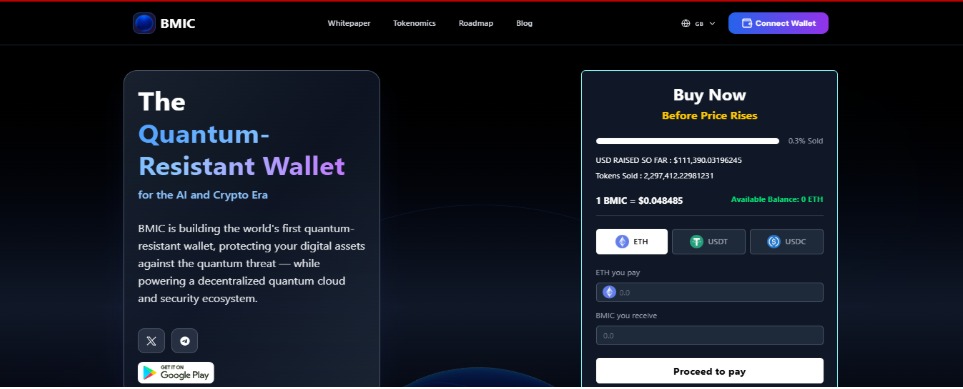Understanding BMIC
BMIC, which stands for Blockchain Micro-Ion Compute, has been developed with the explicit purpose of safeguarding the digital world as we approach the era of quantum computing. As quantum technology continues its rapid advancement, the encryption methods that currently form the backbone of our digital security are expected to become increasingly vulnerable.
This anticipated weakening of current encryption poses a significant risk to blockchains, digital wallets, and online identities. The BMIC Wallet is engineered to provide robust protection against these future threats by incorporating post-quantum cryptography (PQC). This technology aims to ensure that digital assets remain secure, both in the present and for years to come.

BMIC Roadmap and Development Phases
The BMIC Crypto roadmap outlines a clear and organized vision for the platform's growth, particularly in anticipation of a future increasingly shaped by quantum technology. Recognizing the accelerating pace of quantum computing development and the associated security risks to existing blockchain encryption, BMIC is strategically positioning itself to address these challenges proactively.
The roadmap details critical steps, including the creation of a quantum-resistant wallet, the promotion of post-quantum cryptography adoption, the launch of enterprise-grade Quantum Security as a Service (QSaaS), and the integration of quantum computing capabilities into a decentralized network.
Phase 1: Foundation (In Progress)
This initial phase focuses on the foundational development of the BMIC Quantum-Resistant Wallet, with a Minimum Viable Product (MVP) as the primary objective.
- •Begin development of the BMIC Quantum-Resistant Wallet (MVP).
- •Align with NIST-approved post-quantum cryptographic techniques to ensure secure transaction handling and key safeguarding.
- •Initiate the creation of the primary BMIC token smart contracts on the Ethereum network, utilizing the ERC-20 framework.
- •Deploy a recent release emphasizing a wallet-centric approach, computer integration, and Software as a Service (SaaS) capabilities.
- •Engage with institutional partners, including fintech companies, banks, exchanges, and other firms, to commence trial collaborations.
Phase 2: Wallet Alpha & Security APIs
Phase 2 introduces the Wallet Alpha Release, granting early access to users and incorporating multi-asset storage and basic staking functionalities.
- •Launch white-label wallet versions in collaboration with a select group of enterprise associates.
- •Initiate the deployment of APIs designed to allow businesses to leverage PQC encryption for maintaining key security.
- •Enable institutional participants to manage staking nodes, thereby enhancing the network's stability and overall strength.
- •Provide transaction security notifications and risk-detection updates for users.
- •Execute the first token burn event to reinforce BMIC's deflationary supply model.
Phase 3: Wallet Beta & Governance
The Wallet Beta Launch signifies the public release of a comprehensive multi-asset wallet, featuring cross-chain interoperability and Decentralized Application (DApp) integration.
- •Implement governance features that empower token holders to vote on protocol-related decisions.
- •Integrate post-quantum encrypted messaging and communication capabilities within the wallet.
- •Introduce burn mechanisms and revenue-supported buyback strategies to support the long-term value of the BMIC token.
- •Offer tools that comply with HIPAA and GDPR requirements, suitable for use in healthcare and fintech trial programs.
- •Conduct routine token burn cycles to manage and support a deflationary supply model.
- •Allow token holders to participate in early-stage voting on proposals that shape the future direction of BMIC.
Phase 4: Quantum Meta-Cloud Integration
Phase 4 expands BMIC's scope beyond a wallet, evolving it into a complete compute ecosystem.
Compute API Integration will connect the wallet and QSaaS to partner quantum providers.
- •Enable users to exchange their BMIC tokens for BCC to facilitate quantum processing tasks.
- •Introduce NFT-based priority access for managing high-demand, compute-intensive operations.
- •Present APIs that support online identity services, secure asset custody, and compliance-focused integrations.
- •Extend the utilization of institutional partnerships beyond initial test deployments.
- •Manage ongoing burn procedures that are integrated with network usage and revenue generated by the wallet.
Phase 5: Mainnet & Scaling
The BMIC Mainnet Launch will establish a decentralized network comprising wallets and QSaaS nodes.
- •Transition to a DAO-based governance model, granting overall control of major decisions to participants.
- •Implement adaptive cryptography that automatically updates in accordance with new NIST-approved PQC standards as they are released.
- •Drive broader BMIC adoption across diverse industries, including insurance, finance, supply chain, healthcare, and more.
- •Scale and empower the system to manage millions of users with enterprise-grade stability.
- •Continue regular token burn cycles tied to platform usage, revenue generation, and overall network activity.
Conclusion
BMIC is actively laying the groundwork for a more secure online world as we advance into the quantum era. With the rapid enhancement of quantum computers, the risks to the broader crypto landscape, online identities, and blockchain technology are becoming increasingly significant.
The BMIC Crypto roadmap illustrates a structured, step-by-step procedure designed to secure enterprise-level post-quantum security and online assets. This initiative aims to deliver decentralized quantum computing capabilities and foster a transition towards community-led governance.
Through its next-generation wallet, QSaaS APIs for universally scalable compute networks and businesses, BMIC is positioning itself at the forefront of quantum-resistant blockchain technology.

